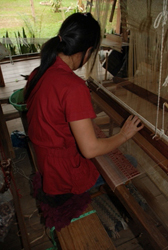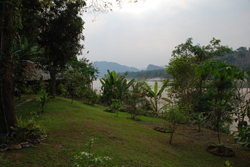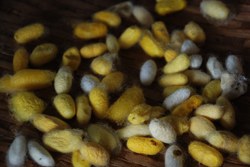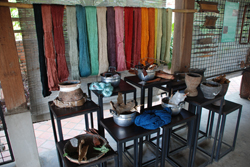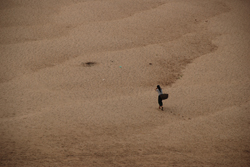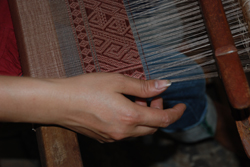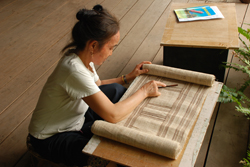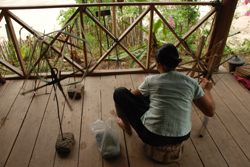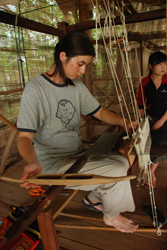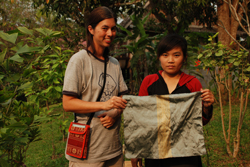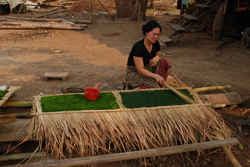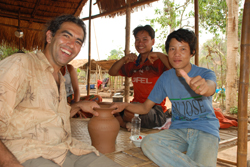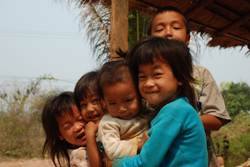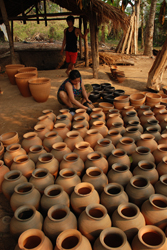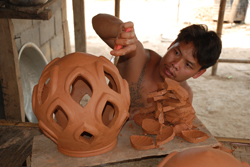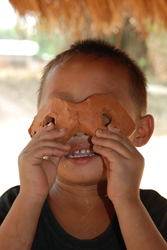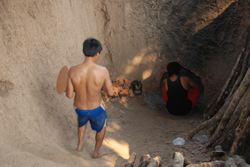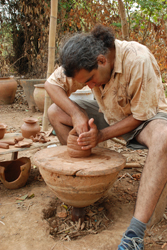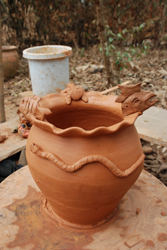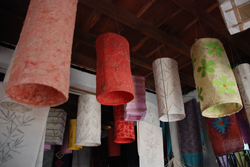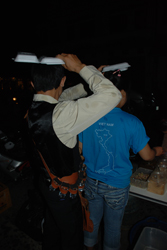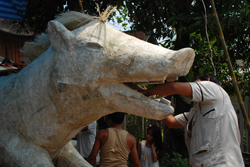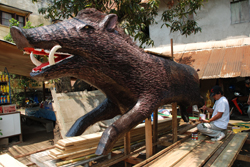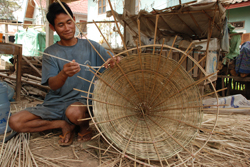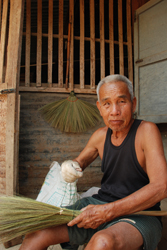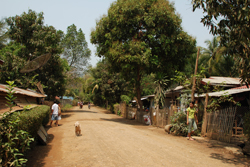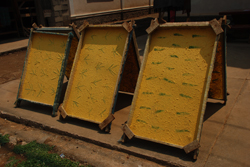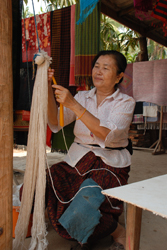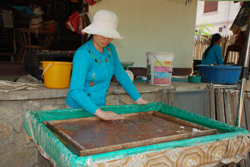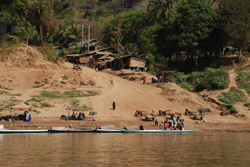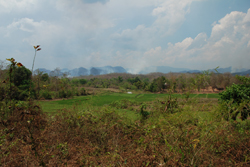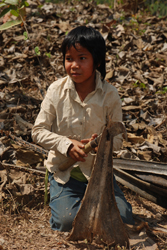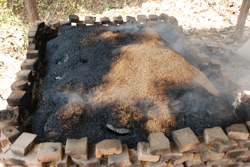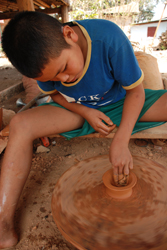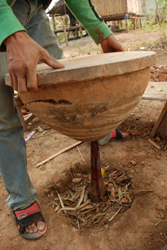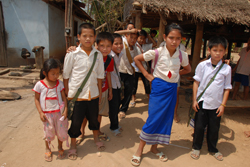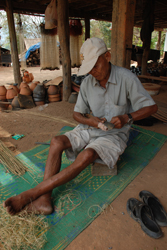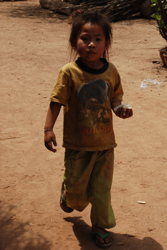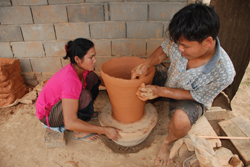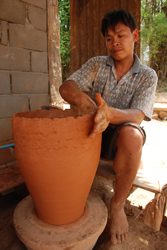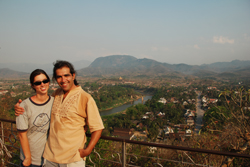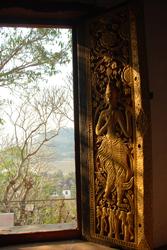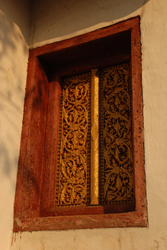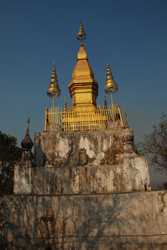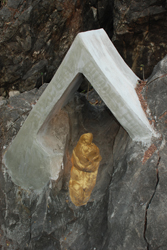Luang Prabang: Tamia Weaves a Placemat and Rowshan Makes a Big Pot
30 March, 2009, 11:56 am in "Laos"
Yesterday I took a weaving class at the Ock Pop Tok weaving center. We had visited both the Ock Pop Tok galleries in the center of town. At the first gallery, a woman walked by and raved about how she had just visited their weaving workshop south of town.
Ock Pop Tok is a Fair Trade textile organization. They create high quality designs which merge traditional and contemporary aesthetics. The silk pieces are beautiful. They dye silk with natural dyes and weave by hand on huge looms. They also have the “Village Weaving Project” so weavers in villages can sell their work (as well as other textile pieces). The workshop is in Luang Prabang but in a village absorbed by the city. The workshop center occupied a beautiful location on the river. The grounds were filled with flowers and trees, many signed and used for dye or food.
Young Rooster
Ock Pop Tok is a Fair Trade textile organization. They create high quality designs which merge traditional and contemporary aesthetics. The silk pieces are beautiful. They dye silk with natural dyes and weave by hand on huge looms. They also have the “Village Weaving Project” so weavers in villages can sell their work (as well as other textile pieces). The workshop is in Luang Prabang but in a village absorbed by the city. The workshop center occupied a beautiful location on the river. The grounds were filled with flowers and trees, many signed and used for dye or food.
The grounds had several buildings-- 3 were completely open with just roofs to protect them from the weather. They were the weaving, dying, and weaving class/batik buildings. One building was a traditional wood house. The open area underneath was a shop/gallery/cafe and exhibit space where there were samples of silk cocoons (and silkworm eggs with a couple tiny worms), weaving tools, and the natural plant parts used for dye. The cafe had a lovely view of the river and people walking across the sand bar.
The weavers are all women though the master weaver/dyer was male. Men also built the looms. The women learned to weave when they were children. They were paid by the piece and could make $80-100 per month. There were 2 main techniques for weaving-- one type wove just one color at a time. They used a template consisting of woven strings in a vertical warp. The woven strings when pulled up to the top of the template would change the strings of the loom making it easier to make the complex patterns like nagas or hooks. The second type of weaving involved adding colored patterns by hand. This was how I'd seen colors woven into other weavings around the world.
My translator/ instructor was a young man named Morn who was studying tourism management in the evenings and worked at the center during the day. He showed me the different plants in the garden. Then we took a quick tour of where the weavers were working. Then we went to the dye work area where the 2 masterweavers/ dyers were dying ikat pieces (tie-dyed), indigo, as well as solid colors. I chose 3 colors to prepare: orange which came from annatto seed which I ground a bit with a mortar and pestle before dumping it into boiling ash water (lye); lemongrass for yellow: one of the nicer smelling dyes just needed to be chopped up and thrown in boiling water; sappan tree wood: this wood usually produces pink but if a nail is boiled with it it makes purple. This dye is “fermented”. The mix is boiled and left in a vat. Dye is taken from it, mixed with boiled water and after the dying is finished it is returned to the vat to ferment some more. Indigo is also fermented.
Dying the silk, then rinsing it and hanging it in the sun to dry was a quick process. While the silk was drying I chose 2 colors from previously dyed silk to weave: light blue and gold.
These we took to the weaving area where Thor, one of the weavers who was my teacher for the day, showed me how to wind the thread onto bamboo spools. I thought the contraption-- 2 rotating bamboo frames, was a bit complex for just winding thread but I guess it also smooths the thread.
These we took to the weaving area where Thor, one of the weavers who was my teacher for the day, showed me how to wind the thread onto bamboo spools. I thought the contraption-- 2 rotating bamboo frames, was a bit complex for just winding thread but I guess it also smooths the thread.
Then Thor did some finishing adjustments to the loom and tightened the warp threads. Setting up the loom and the warp threads takes 3-7 days so I wasn't able to see how that is done. The warp threads which are thin strands of silk-- like spider webs, have to be threaded through a comb and wrapped by hand. But once the loom is set up it can weave 50-60 meters of fabric. Another time consuming part is the pattern parts are set into strings which are attached to heddle strings (sets of strings tied to the warp). A second heddle set are knotted to alternating strings which are operated by bamboo peddles to do the straight solid fabric weave. Thor was making sure the warp threads were tight by pulling the individual strands. Then she wove a rough edge of cotton string to hold the new weaving. She started operating the pedals with one foot: toe pushing one pedal, heel pushing the other and sent the shuttle flying between the warp threads. Then I tried. It was fairly straight forward though I had to go a lot slower than Thor. Thor and Morn hung out while I wove but jumped to action whenever there was a problem: a warp thread loose or the spool thread getting tangled.
After lunch, Thor added the shuttle of gold thread and showed me how to weave the pattern section. This was done by taking a string form the pattern heddle, moving it up and using it to separate the 2 heddle sets of strings. Then I pulled the front heddle strings up which lifted one set of warp strings which would create the pattern. A wooden piece, slid between the strings held the pattern which lasted for 2 passes of the gold shuttle (blue used the regular heddles operated by the peddles). Then the next string was moved up. This took some coordination but wasn't complicated. When I was finished with the piece, Thor cut the piece from the loom and set up the loom for the next piece. Then she pulled out the cotton string and twisted the end threads into a fringe against her leg. I left with my day's work, a pretty silk place mat and some skeins of dyed silk.
While I was weaving, Rowshan went to the pottery village and learned to make big pots. There, he also got to experience some other aspects of Lao life: seeing a woman drying river weed, a popular snack, drinking rice whiskey and hearing a young rooster learning to crow.
Young Rooster
He also got to see potters making clay lanterns which are popular fixtures at many of the hotels and restaurants. That day the villagers were loading the huge underground kiln. Rowshan was able to look inside.
Rowshan made a large pot and gave it characteristic Rowshan style decorations. Of course, since it was large, we didn't want to take it with us (or ship it) so Rowshan left it so his friends in the village would have something to remember him by.
Luang Prabang: Village of Mulberry Paper and Silk
28 March, 2009, 11:56 am in "Laos"
There was quite a bit of rain last night. As we went out for dinner to our favorite phad thai maker, big drops of rain began to fall. As the phad thai girl started cooking our order it began to pour. A girl who was helping her quickly cleared off the containers of condiments-- ground peanuts, chili, limes, salt. A young guy who looked like he might be a bartender at the bar who was also waiting for his order held styrofoam take out containers over her head as an umbrella. She finished our order and as we sat in the covered area of a closed business across and ate, the rain stopped.
Ban Sang Khong is a handicraft village on the other side of the Khan river. We walked through town passing some men working on a giant paper-mache boar. Crossing a bridge brought us to a road which alternated between muddy and dusty. At one house we noticed a guy making a large conical bamboo basket. Another older man was making brooms while the women were all busy embroidering cross stitch pieces.
We knew we'd arrived in the village when we saw screens with drying paper with leaves pressed into it in front of shops. There were also many textile shops with large looms and weaving areas. We stopped in one where I noticed some beautiful contemporary silk weavings. Outside there was a black kettle where silk was being boiled with dye. I looked at the pieces. The woman working in the shop was the designer-- occasionally she ran out to check the silk. Several women were weaving outside. The scarves and runners were dyed with natural dyes. The colors were silvery blues, golds, grass green ,and golds. She told me how the silk was Lao silk and all pieces were made in Laos (locally) She had weavers work on site but embroiderers and women who crocheted pieces worked elsewhere.
Luang Prabang: The Pottery Village, Ban Chan
27 March, 2009, 11:56 am in "Laos"
Today we got a comparatively early start and to our amazement the sky was clear and blue. It may be the first day in Laos since we've been here when the weather was both haze free and the sky was clear. We took a ferry (made of 2 long boats attached with a platform between to the other side of the Mekong to visit the pottery village. The village across from Luang Prabang is called Ban Xieng Mean. I was surprised to find a tourist info office for the region (Chomphet) which was staffed by a young man who was very helpful and well informed. He told us how to get to the ceramics village as well as about some of the sights in the region and available treks.
We headed up a dusty road towards Ban Chan and were relieved when it branched off to a smaller road with no cars. The air was hot and dripped with lethargy but was hypnotically peaceful with the sounds of birds, the buzz of cicadas, humming of bees and flashing of butterflies in the shady parts of the forest.
Alongside the path were tangles of bushes and vines. The forested parts were often burned leaving the area lacking shade. Beyond the jungle paths were vistas of rice paddies, fish ponds and wooden houses. Beyond, blue mountains spread into the distance, plumes of smoke rising to fill the momentarily pristine air.
Alongside the path were tangles of bushes and vines. The forested parts were often burned leaving the area lacking shade. Beyond the jungle paths were vistas of rice paddies, fish ponds and wooden houses. Beyond, blue mountains spread into the distance, plumes of smoke rising to fill the momentarily pristine air.
Sometimes a cool breeze teased us. Sometimes we'd see someone. A woman and her kid were chopping up palm branches and eagerly waved at us.
We reached the village, first passing a brick structure with a pile of burning rice husks covering it. When we walked back through the husks had burned enough to reveal blackened pots underneath.
I guess it was already hot for working since we didn't see anyone around making pots. Though there were pots-- large terracotta ones-- drying in the sun.
A boy came running out gesturing us to a demonstration wheel with a couple wooden seats next to it. The wheel was a hole dug in the ground with a spindle buried in it. The wheel was made of carved wood-- a half sphere with a flat surface on top. To make it run slightly evenly, the spindle needed to be wet. The boy threw a heavy rudimentary piece. Then Rowshan tried and produced a couple rather rough ugly pieces as well. The boy was turning the wheel and every now and then it would make a grating noise and suddenly bump up and down a bit making any smooth delicate work impossible. Meanwhile the kids of the town seemed to be arriving home from school. They gathered around and watched and laughed.
A boy came running out gesturing us to a demonstration wheel with a couple wooden seats next to it. The wheel was a hole dug in the ground with a spindle buried in it. The wheel was made of carved wood-- a half sphere with a flat surface on top. To make it run slightly evenly, the spindle needed to be wet. The boy threw a heavy rudimentary piece. Then Rowshan tried and produced a couple rather rough ugly pieces as well. The boy was turning the wheel and every now and then it would make a grating noise and suddenly bump up and down a bit making any smooth delicate work impossible. Meanwhile the kids of the town seemed to be arriving home from school. They gathered around and watched and laughed.
We walked around the village looking for adults working. We found one man shaving bamboo to make into baskets. He had a newly finished large pot near him but wasn't going to be working on clay since he had baskets to do.
Kids wandered around each holding a hand-full of sticky rice with pork sausage filling. We went back towards the boy's house where he said, a “Big Fire” was happening. There, his mother showed us the kiln. It was a huge covered pit with a door at the bottom, which led to an underground chamber. From above ground we could see pots deep below through the chimney.
We walked down another path where the kids' school must be since more kids were walking down it. Then we saw a house with a large pot sitting on a wheel and a man wedging clay. He said he would be working again at 1. It was only 11:30. Nonetheless, he eventually sat down and with his wife turning the wheel and feeding him pieces of clay he threw a large coiled piece for us to see even though it was his lunch break. Rowshan arranged to learn to make a large piece on Monday.
In the afternoon we went up Mt. Phusi and looked at the city below. It is a beautiful city. Small but filled with trees. Wats glittered golden and the river curved through it. Mountains surround it. Martin said Luang Prabang is considered, “The most beautiful city in SE Asia.”
At the top of the hill is a gold stupa. Lower down are more stupas and a cave. There was also a “footprint of Buddha” - a vaguely foot shaped indentation in a rock painted gold.
Powered by My Blog 1.69. Copyright 2003-2006 FuzzyMonkey.net.
Created by the scripting wizards at FuzzyMonkey.net..
(Code modified by Rowshan Dowlatabadi)
Created by the scripting wizards at FuzzyMonkey.net..
(Code modified by Rowshan Dowlatabadi)


